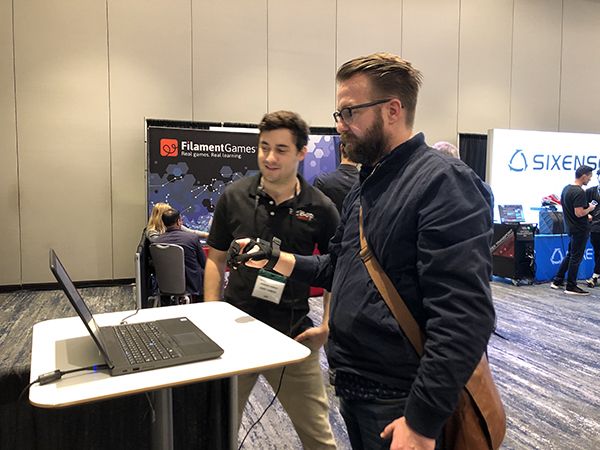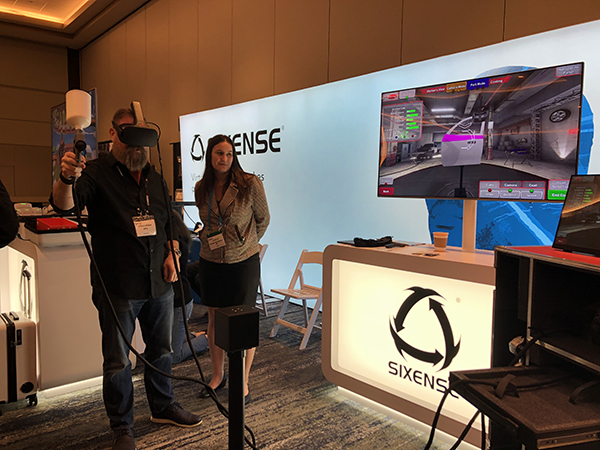VRX Conference: Moving from Visuals to Interaction
AR-VR event shows developers adding new ways to interact with digital models

An attendee tries out gloves equipped with BeBop sensors for interaction in mixed reality at the VRX 2019 Conference.
Latest News
December 16, 2019
In the early phase of a technology, the Wow factor usually takes center stage. Quite often, that in itself is sufficient to convince an investor. However, as the market and the technology mature, people begin demanding something of substance. At VRX Conference in San Francisco last week, Maddie Callander, VR Accelerator & Portfolio, Boost VC, made this point in a panel discussion titled “Are investors done with XR?”
“Take VR out of your pitch. What problem are you solving? VR is just one of the mechanisms to solve that problem; you don’t need to define yourself as a VR company,” said Callander.
On the exhibit floor, the demos indicate the XR (extended reality) industry has moved beyond high-resolution visuals. The brain wave monitoring sensors, haptic gloves, and new controllers point to the search for a more natural way to interact with digital objects.

LOOXID Labs: Emotion Monitoring with XR
When someone is looking at a virtual car or furniture through an XR head mounted display (HMD), do you know how they actually feel? In the feedback, the test subject may rate the design favorably but is he or she telling the truth? This is where LOOXID Labs hopes to give you insights with what it calls “brainwave sensing technology.”
It offers an add-on unit that attaches to the top of the HMD. With it, you can now monitor the AR-VR user's brainwave activities as graphs. Used in conjunction with eye-tracking, this allows you to deduce, for instance, that the user shows signs of excitement when he or she looks at a specific region of the virtual car. For product development, LOOXID Labs' technology can pinpoint specific design options or configurations that prove most appealing to early testers.
The science behind it, is based on Electroencephalography, or EEG. “EEG is used in a variety of fields where unbiased, unconscious data are pivotal,” the company writes.
Holo-Stylus: Scribble in AR
Holo-Stylus showcased its pen at the show, to demonstrate how you might write notes and draw inside XR. The company describes it as “a tool with the precision of a surgical instrument and the user-friendliness of a pen.” The device's accuracy is “down to the millimeter through our AI based tracking technology,” according to the developers.
Peripheral maker Logitech also recognized the need for a writing and sketching instrument for AR-VR. This month, it released the Logitech VR Ink Pilot Edition, supporting VIVE and Varjo headsets. Such a device could be a critical component in deploying specialized 3D surfacing and modeling software for AR-VR. One of the software partner for VR Ink is flyingshapes, billed as VR CAD for Designers.
TGO: SDK for Capturing Hand Gestures, Simulating Sensation
UK-based sensor developer TGO hopes to pitch its SDK to MR application developers as a way to simulate haptic feedback. Called etee, the SDK comes with a pair of hand-gripping controllers with sensors inside. The sensing area—the track pad covering the controller's surface—can generate vibration or tension in response to the user's interaction with digital objects (for example, feeling resistance when pushing on solids in VR).
The controllers can also mimic hand gestures based on skin contact with the track pad; therefore, they can be used to mimic the user's open handed outreach, close-fist movements, and so on.
The SDK is priced £1,500 ($2,000), but the regular units will retail for £219 ($292) to £239 ($319), according to Jakub Kamecki, VP of Business Development and Partnership, TGO.
“The feedback from consumers and early testers is that the controllers are very accessible and easy to use. This makes them a clear fit for corporate training, and location-based entertainment, where casual users are expected to quickly pick up and play and interact with the content,” said Kamecki. “We've had some interest from companies in the robotics space to control their robots remotely.”
Also present at the show was BeBop sensors, which produced the Forte Data Gloves that you can wear to interact with digital objects in MX applications. The product takes “workplace training to the next level by enabling natural hand interaction and providing haptic feedback to help you create the most intuitive and immersive VR training experience for skilled workers,” the company writes.
The two-day conference is produced by Reuters. A similar event called XR Immersive Enterprise 2020 is set for Boston (May 5-6).
Subscribe to our FREE magazine, FREE email newsletters or both!
Latest News
About the Author
Kenneth Wong is Digital Engineering’s resident blogger and senior editor. Email him at kennethwong@digitaleng.news or share your thoughts on this article at digitaleng.news/facebook.
Follow DE





